This post may contain affiliate links. If you click through a link and make a purchase, I may receive a commission at no additional cost to you. As an Amazon Associate, I earn from qualifying purchases. Read the full disclosure here.
Sciatica is a widely accepted catch-all term that people use to describe pain in the back and hip, radiating down the back of the leg. It may surprise you to learn that sciatica itself is not a diagnosis; it’s a symptom (with several possible causes).
When you have sciatica, it feels like everyone is a doctor, sharing their personal experience. As a physical therapist, I find there’s a ton of misinformation circulating about sciatica.
Here are 13 things to avoid when you have sciatica, plus plenty of tips to help you get better faster.
Disclaimer: This content is for educational purposes and is not medical advice. Read the full disclaimer.
What to avoid when you have sciatica
You’ll need to know what’s causing your sciatica to get the right exercises.
However, an essential part of getting better is understanding what things to avoid when you have sciatica to avoid painful exacerbations.
Here are the top things you shouldn’t be doing if you’re experiencing sciatica symptoms. (More detail for each is provided below!)
1. Avoid Googling “exercises for sciatica”
I get it. When you have sciatic pain, you’re looking for immediate relief.
The internet is an easy way to research and learn about health conditions (from quality sources, of course), but if you’re asking the wrong questions, you’re going to get the wrong answers.
Plenty of people out there are willing to offer you bad advice, especially in places like Facebook groups and message forums. Following the wrong advice can lead to feeling worse.
Taking an active role in your health doesn’t mean going rogue and self-diagnosing, and self-treating.
If sciatica is a symptom with several possible causes, there isn’t one magical sciatica exercise that magically fixes everyone.
For example:
- If a lumbar herniated disc causes nerve compression, extension exercises might benefit the program.
- If the sciatica pain is due to lumbar stenosis, flexion exercises might be the way to go.
- If the discomfort results from an SI joint dysfunction, either of those movements might aggravate the pain.
- If it’s piriformis syndrome, spinal range of motion exercises likely won’t help.
- There can be multiple conflicting issues occurring at once that change the appropriate treatments.
This is why you need more specifics about your condition.
There are plenty of great exercises for sciatica. However, whether or not they’re great for your sciatica is another story.
Related read: Yoga Poses To Avoid With Sciatica
2. Aggressively stretching your hamstrings
The sciatic nerve runs along the same path as the hamstrings. The position to stretch the hamstrings will also pull on the sciatic nerve. If the sciatic nerve is irritated, putting tension on the nerve by stretching will most certainly aggravate the pain, like pulling a rope at both ends, (except that rope is made of highly sensitive nerve tissue.)
Examples would be bending over to touch your toes with straight legs or sitting with your legs out and leaning forward to touch your toes. This also includes downward facing dog. Bending the knees is a quick way to decrease tension off of the sciatic nerve if these movements are unavoidable.
If you find that these motions aggravate your pain, make a note, and modify your movements to pain-free motions.
Use props like a stretch out strap to keep yourself safe and avoid overstretching.
3. Forward bending
Many cases of sciatica are related to a lumbar disc herniation. Forward bending flexes the spine and tends to be a culprit to aggravate disc issues, worsening radiating pain like sciatica.
Inside of each spinal disc is a gel-like substance (the nucleus pulposus). As we move, the nucleus shifts within the disc to distribute pressure and force through the spine.
In the case of a disc herniation, the nucleus can herniate or balloon out of the outer fibrous material, pressing on spinal nerves. Due to human anatomy and the way we move, discs typically herniate toward the back of the body with forward bending activities.
Daily activities such as bending forward to pick something up or gardening activities can also tension the sciatic nerve and make you feel worse.
If you find that forward bending aggravates your sciatica, aim to keep a neutral spine and bend the knees during everyday activities.
4. Pushing through the pain
The no pain, no gain mentality will come back to bite you. Subscribing to this outdated, old-school phrase does more harm than good.
Instead, get in tune with pain/symptoms vs. the sensation of muscles working.
Differentiating between these can help you avoid taking one step forward and two steps back in your rehab process. This goes for everyday activities too.
Smart activity modification can help you get better faster.
Less pain = more gain.
5. Heavy lifting
Heavy lifting, especially squats, deadlifts, and bent-over rows, can further irritate an angry sciatic nerve. Be sure that you’re properly warmed up and have prepared your body for these movements.
In more acute stages, take a step back and let yourself heal so you can return stronger and better than before. This might look like focusing on more mobility or accessory lifting activities to support the body when it’s time to return to your regular program.
6. High impact exercises
High impact exercises take a toll on the muscles and joints of the body. There are plenty of low impact workouts to keep you moving.
If something is already irritated, high impact exercises will likely worsen the problem.
Modifying your activity temporarily to allow your body to heal is not phoning it in; it’s smart activity modification.
7. Certain abdominal exercises
Some abdominal exercises (like double leg lifts and sit-ups) can place a lot of pressure on the lower back.
If your symptoms are a result of a lumbar disc herniation, aggressive abdominal exercises will likely aggravate the situation due to the flexed position of the lumbar spine.
(To be honest, sit-ups aren’t even a great exercise to work the core muscles anyway. Also, having visible abdominal muscles (aka six-pack) doesn’t guarantee functional strength or spinal stability.)
8. Extreme spinal movements
Extreme spinal movements in any direction can further compress irritated tissues.
You might be thinking “I don’t do extreme spinal movements.” But keep in mind this term is relative, and if you’ve lost some range of motion, “extreme” might be closer than you think.
Even twisting movements like turning to reach something in the car’s back seat can be aggravating to sciatic pain. It depends on your body.
This also includes attempting to crack your own back, which we’ll get into later in this list.
9. Sitting or standing for too long
Excessive time in any one position can aggravate sciatic pain. What’s too long? This will vary from person to person. More irritable symptoms may start in less than 10 minutes. Others may find 30 minutes is their max.
Consider using a lumbar support pillow to maintain your natural alignment while sitting and avoid excessive lumbar flexion.
When lying down, a wedge to elevate the legs can help support and take some pressure off of the spine. If you’re a side-sleeper, a body pillow can help keep irritated tissues aligned to get a better night’s rest.
10. Avoid long trips
Whether it’s road trips or flying on a plane, travel tends to keep you captive in less than comfortable positions for far too long.
If you’re forced to spend more time in painful positions, this can really compound as the day goes on.
If you need to travel long distances, you can always consider bringing a lumbar support or trying a TENS unit to relieve extra pain from cramped airplane seats.
Also, consider getting up more frequently to do some stretches and give your tissues a much needed break.
11. Relying only on passive treatments
Ice and heat for sciatica certainly can have a place, but relying on passive treatments alone (treatments that require no effort on your part) ultimately does not fix problems.
The body also needs a combination of activity modification and progressing loading of tissues to decrease pain and get stronger.
A physical therapist can help you determine safe ways to move to get on the right track to feeling better.
12. Cracking your own back
Sometimes it feels like you’re one good crack away from being “aligned” and pain-free. Spinal manipulation can be helpful for some people meeting certain criteria (and when it’s performed by a professional.)
If you’re back doesn’t want to crack easily on its own, avoid straining and forcing yourself into complex positions. Remember, there’s not a lot of space near the spine, and one small shift could leave you feeling worse than before.
13. Anything that aggravates your symptoms
Not everyone follows textbook patterns when injured.
Nerve tissue is incredibly sensitive, and it’s possible to pay for this for hours or even days after exacerbating your symptoms. Make sure you’re listening to your body.
Keep reading to learn more about sciatica and tips to get better faster.
Sciatic nerve anatomy
The sciatic nerve is the longest nerve in the body and originates from multiple nerve roots in the lumbar spine (lower back), forming a left and a right sciatic nerve.
Anatomy varies but generally starts around the piriformis muscle (at the back of the hip) and runs down the back of the thigh, splitting off into smaller nerves behind the knee. These branches then continue to the foot.
The sciatic nerve provides motor function (allows you to move your muscles) directly and indirectly to the lower body’s major muscle groups, including the hamstrings and adductors with branches to lower leg muscles and feet. (Davis D., 2020)
More distal branches provide sensation to the back of the leg and parts of the foot.
A common question is does sciatica press on the spinal cord? Not exactly, the spinal cord actually tapers off around L1-2 levels, transitioning into a collection of nerves resembling a horse’s tail (cauda equina).
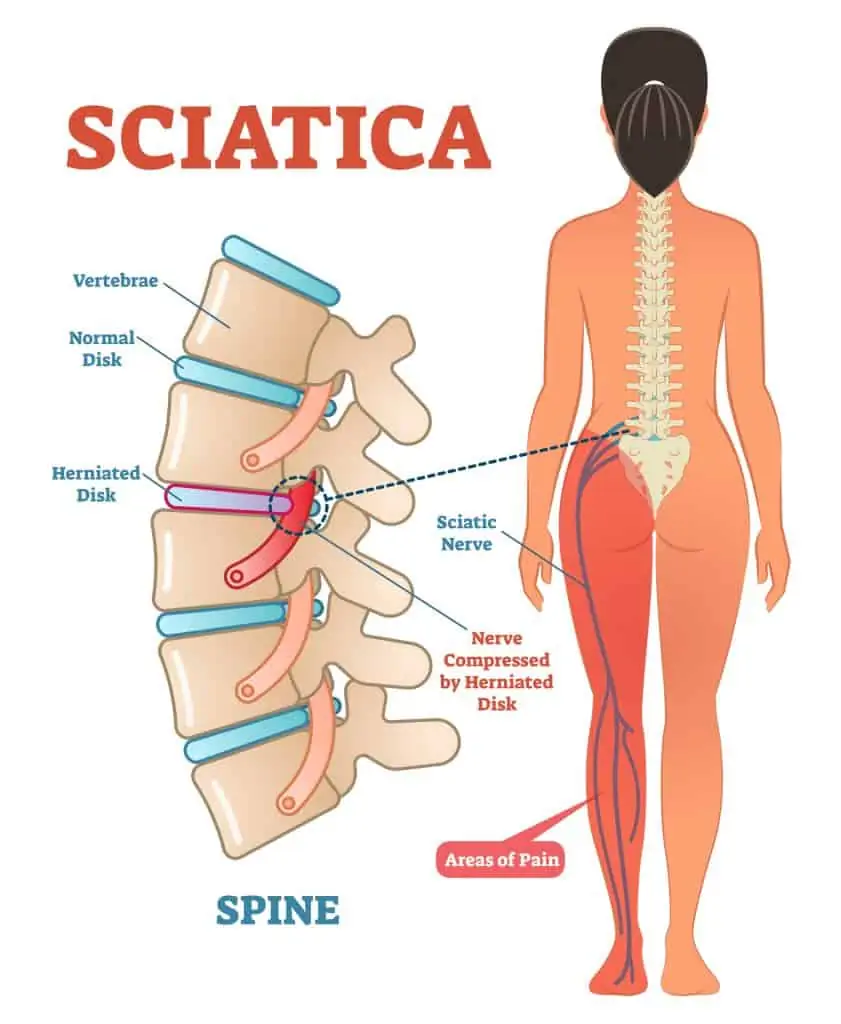
Symptoms of sciatica
Sciatica symptoms vary in intensity and severity.
Some common symptoms of sciatica are:
- Moderate to severe pain in the lower back, back of the hip/buttock, and down the back of the leg
- Sensation changes such as numbness, tingling, pins and needles, or prickly sensations
- Muscle weakness
- Pain and symptoms can be anywhere along the distribution of the sciatic nerve
If any of these symptoms are accompanied by loss of bowel or bladder function or numbness in the area where you would sit on a saddle, get to the doctor ASAP because that’s a medical emergency.
Related read: 3 Signs Your Sciatica Is Improving
Is it sciatica or something else?
Many sciatica cases originate from the spine, such as with a disc bulge, causing inflammation of the lower spinal nerves. This is sometimes referred to as a pinched nerve. But the spine is not the only place this nerve can become irritated.
Dumping all of these leg pain causes into a big garbage can labeled “sciatica” gets confusing in a hurry.
Several issues can cause sciatica-like pain by either irritating the sciatic nerve along its path (like in piriformis syndrome) or causing referred pain down the leg in a similar pattern (such as from a muscle spasm from the glute minimus.)
Pseudo-sciatica (also not a diagnosis) doesn’t mean your symptoms are fake. It just means that you could be experiencing sciatic-like symptoms and not true sciatica.
But the pain is real, and the right cause needs to be determined to get healthy again.
Related read: Piriformis Syndrome vs. Sciatica
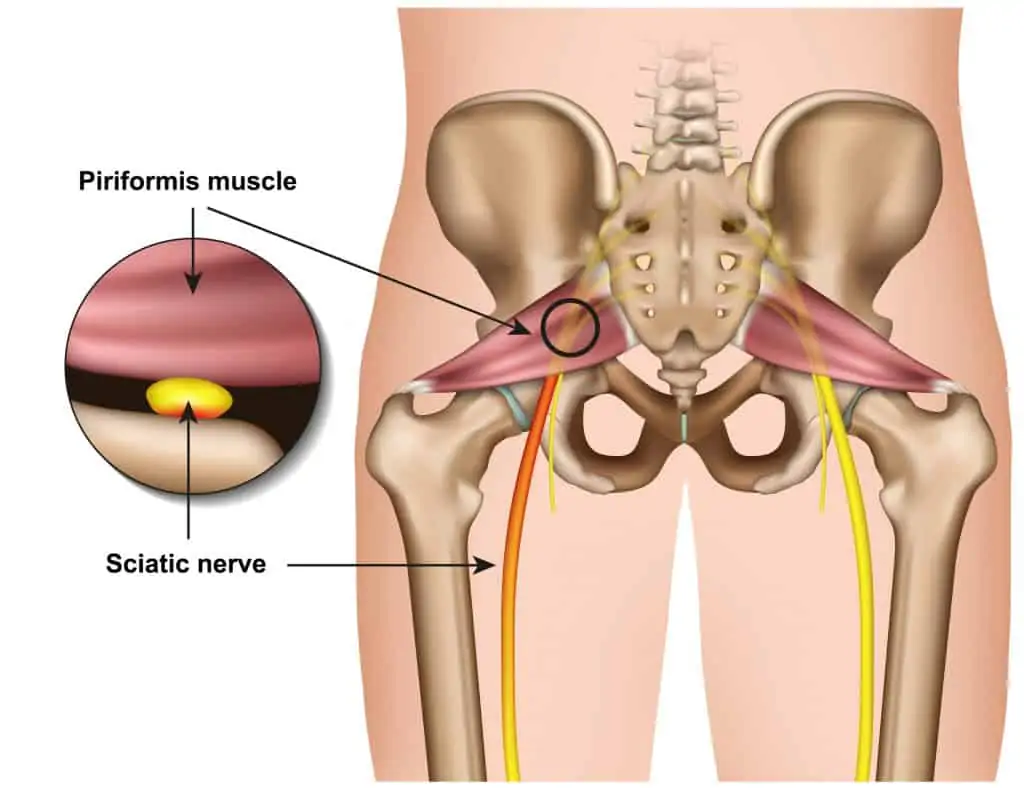
What causes sciatica to flare up?
Sciatic nerve pain can result from any irritation to the sciatic nerve. Here are some potential ways this tissue can become angry.
- Lumbar disc bulge or herniation (slipped disc)
- Impingement at the lumbar nerve root
- Muscular spasm
- SI joint issues
- Piriformis syndrome
- Pregnancy
- Spinal stenosis
- Degenerative disc disease
- Spondylolisthesis
- Arthritis
- Limited hip mobility
- Trauma
- Malignancies or infections
Conditions such as vascular disease or peripheral neuropathy can mimic sciatic symptoms but are very different conditions.
Hamstring strains can also be mistaken for sciatic nerve pain, but a proper evaluation will tell them apart.
Related read: 3 Signs of Sciatica Improving

Helpful tools for sciatic pain relief at home
Sometimes, you just need to take the edge off the pain to make moving or exercising more tolerable.
Keep in mind that these treatments alone will not “fix” sciatica, but may help you along your way as part of a comprehensive treatment program.
- Bio freeze pain relieving gel
- Large ice packs
- Microwave heat pack
- iReliev TENS unit pain relief system*
- Lumbar support cushion
- Wedge to elevate your legs and relieve low back pressure/pain
*A TENS unit can be a convenient non-drug way to manage pain, but there are two important details to understand.
One, effects are temporary and not cumulative, so using it more doesn’t result in some magical cure. TENS doesn’t “fix” why you’re having pain.
Second, there are precautions and contraindications to using electric stimulation, for example with pacemakers or certain medical conditions. Always speak with a healthcare provider and read all instructions to make sure that you can safely operate the unit.
You can also speak with your doctor about medications, including over-the-counter or prescription anti-inflammatories or pain medication.
Related read: What Do TENS Units Do? (Benefits, Risks, & Myths) and Ice Or Heat for Sciatica?
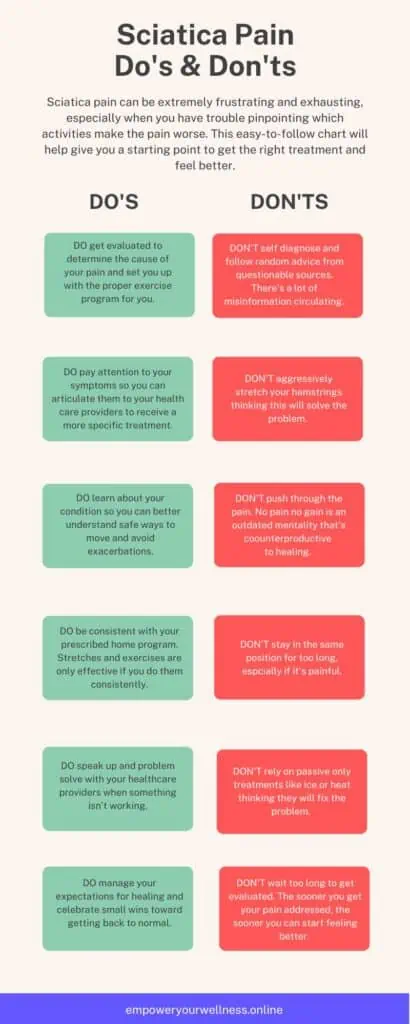
Details that can help identify your sciatic pain
When you visit your physical therapist or chiropractor, they will ask you some questions to help tease out the cause of your pain.
Here are some questions to ponder that can help you (and your healthcare providers) determine what’s causing your symptoms and get you on the right track to feeling better.
The more detail you can provide, the better they can help you get some pain relief.
Don’t forget to grab the free checklist in the box below for everything you need to be prepared for your first physical therapy visit.
Related read: Do I Need An MRI For Back Pain?
Location of the pain
The sciatic nerve travels along a specific path. The location of your symptoms can help determine if it’s sciatica or something else.
Hamstring strains are sometimes confused with sciatica pain, but a proper evaluation can tell them apart.
Quality and severity of your symptoms
The quality of the pain (sharp, dull, achy, numbness/tingling) can be a clue and help differentiate between muscle and nerve pain.
Do you perceive any muscle weakness?
Effect on activity
Try to identify activities/movements that make the pain better and which make it worse. This can help establish a pattern and get you closer to a diagnosis.
How the pain started
Was this a sudden onset after a specific movement, or did the pain gradually increase?
See also, How To Prepare For Your First Physical Therapy Appointment (+Free Checklist) for a head’s up on what to know before you go.

How to get rid of sciatica fast
We’ve spent a lot of time on what not to do. Here are some things you can do to take an active role in fixing your sciatic pain and getting the right treatment faster.
- DO get evaluated to determine the cause of your pain and set you up with the proper exercise program for you.
- DO pay attention to your symptoms so you can articulate them to your healthcare providers to receive a more specific treatment.
- DO learn about your condition so you can better understand safe ways to move and avoid exacerbations.
- DO be consistent with your prescribed home program.
- DO speak up and problem-solve with your healthcare providers when something isn’t working.
- DO manage your expectations for healing and celebrate small wins toward getting back to normal.
Related: What Is Physical Therapy & How Can It Help You
FAQ about sciatica
In this section, I answer some of the most commonly asked questions on Google about sciatica.
Is bed rest good for sciatica?
There is no evidence that bed rest is an effective treatment for sciatica. Like most issues, not moving has greater consequences and can prolong pain and delay healing times.
Is walking good for sciatic nerve pain?
Walking can be an accessible low-impact activity to improve circulation and decrease pain, however, whether or not walking is comfortable for your sciatica will depend on the root cause.
Even with a light activity like walking, it’s important not to overdo it and exacerbate symptoms, as this will prolong the time it takes to start feeling better.
What should I ask my doctor about sciatica?
Remember, sciatica is a symptom, not a diagnosis.
It’s important to ask your doctor what the root cause of your sciatica pain is as well as activities to avoid. Determining the root cause may require a more thorough examination and possibly imaging such as an MRI.
Ask for a referral to a physical therapist to get more details on the right exercises for your specific case as well as activities to avoid.
A simple “take it easy and listen to your body” isn’t that helpful. Be sure to get specifics.
What’s the fastest way to cure sciatica?
- DO get evaluated to determine the cause of your pain and set you up with the proper exercise program for you.
- DO pay attention to your symptoms so you can articulate them to your health care providers to receive a more specific treatment.
- DO learn about your condition so you can better understand safe ways to move and avoid exacerbations.
- DO be consistent with your prescribed home program.
- DO speak up and problem solve with your healthcare providers when something isn’t working.
- DO manage your expectations for healing and celebrate small wins toward getting back to normal.
Why does sciatica hurt more at night?
Certain positions coupled with not moving for several hours can increase pressure on an already irritated sciatic nerve and make symptoms feel worse.
Also at night, there’s little else to distract you as you’re trying to be quiet for sleep, so sensations such as pain become more noticeable.
How long does it take for sciatica to go away?
Generally, sciatic pain lasts 4-6 weeks, however, the answer to this question is quite variable and depends on many factors.
Considerations like how long you’ve had the pain, other medical diagnoses, and your occupation or activities can greatly influence how long it takes to recover from sciatica.
Wrapping up
Sciatica is a symptom, not a diagnosis, and there’s no one-size-fits-all cure.
Resist the urge to self-diagnose and follow some generic lousy advice. To get better fast, it’s essential to find out what’s causing your symptoms to get sciatica pain relief.
Learning what to avoid when you have sciatica is just as important to avoid making the problem worse.
For persistent symptoms, it’s always good to get an evaluation and individualized treatment to avoid chronic pain and nerve damage.
Related:
- How Do You Fix Tight Hip Flexors?
- Best Affordable Physical Therapy Equipment For Home
- How To Prevent Text Neck – Posture & Exercise Tips
- How To Exercise (Safely) With Low Back Pain
References
Davis D, Maini K, Vasudevan A. Sciatica. [Updated 2020 Nov 20]. In: StatPearls [Internet]. Treasure Island (FL): StatPearls Publishing; 2020 Jan-. Available from: https://www.ncbi.nlm.nih.gov/books/NBK507908/
Visser LH, Nijssen PG, Tijssen CC, van Middendorp JJ, Schieving J. Sciatica-like symptoms and the sacroiliac joint: clinical features and differential diagnosis. Eur Spine J. 2013;22(7):1657-1664. doi:10.1007/s00586-013-2660-5
Thiyagarajan, Senthilkumar. (2017). Pseudo Sciatica-It’s the Condition we really Treat Better than Medicine. Journal of Novel Physiotherapies. Volume 7. 10.4172/2165-7025.1000327.



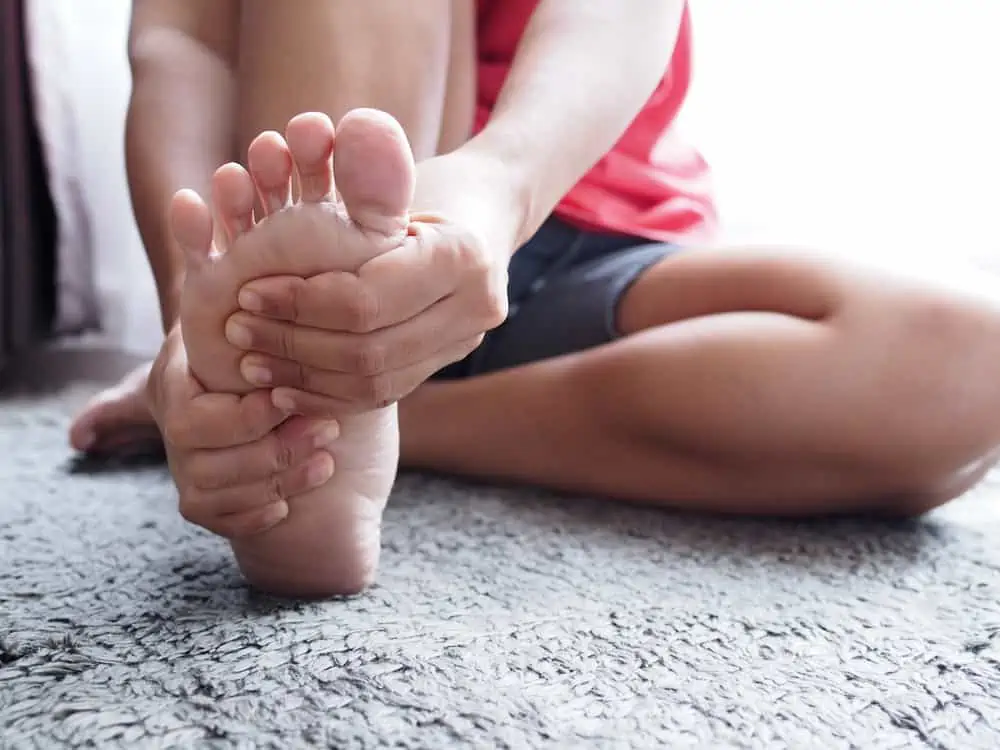
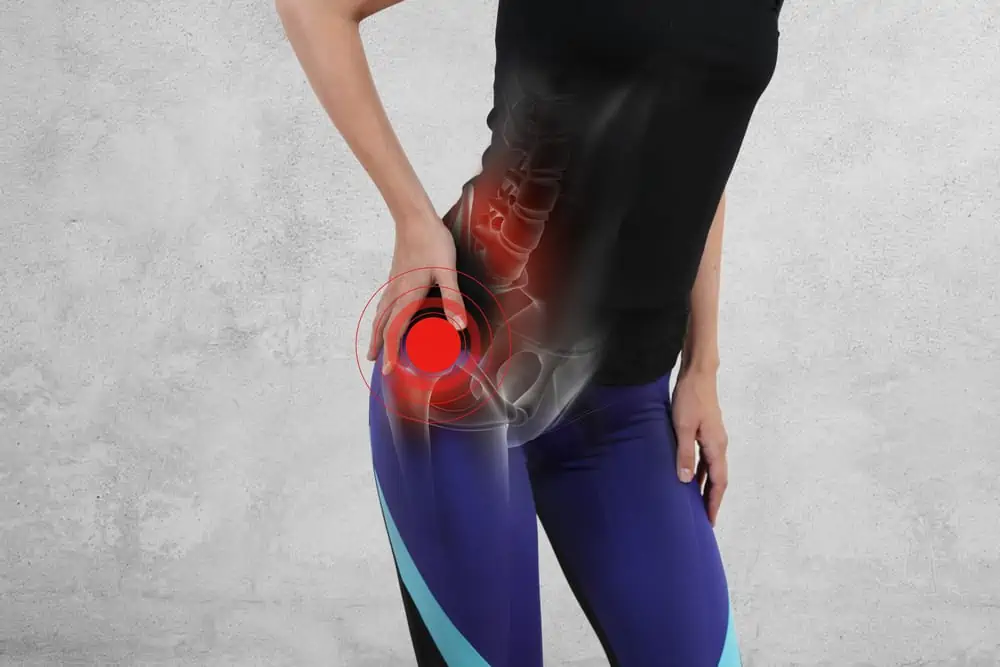



Great article! I wrote one that discusses low back pain in general.
Awesome, thank you for reading.
I appreciate all of your knowledge and tips! My dad had suffered from sciatic pain for years. I’ll have to pass this on to him.
Such a good point to be sure to get evaluated to identify the root cause. You can’t “fix” what isn’t the issue, so you’re just delaying relief.
Thanks for reading!
This is a great write-up – I had it for 9 months and it was awful. It took massage therapy and physical therapy to get over it.
Thank you, glad to hear you’re feeling better.
Thanks for this very informative article. I need, I feel like Im having it and I need to observe/assess myself and consult a professional for this.
I’m glad it was helpful. Yes, get evaluated by a professional if you’re having any symptoms. Good luck!